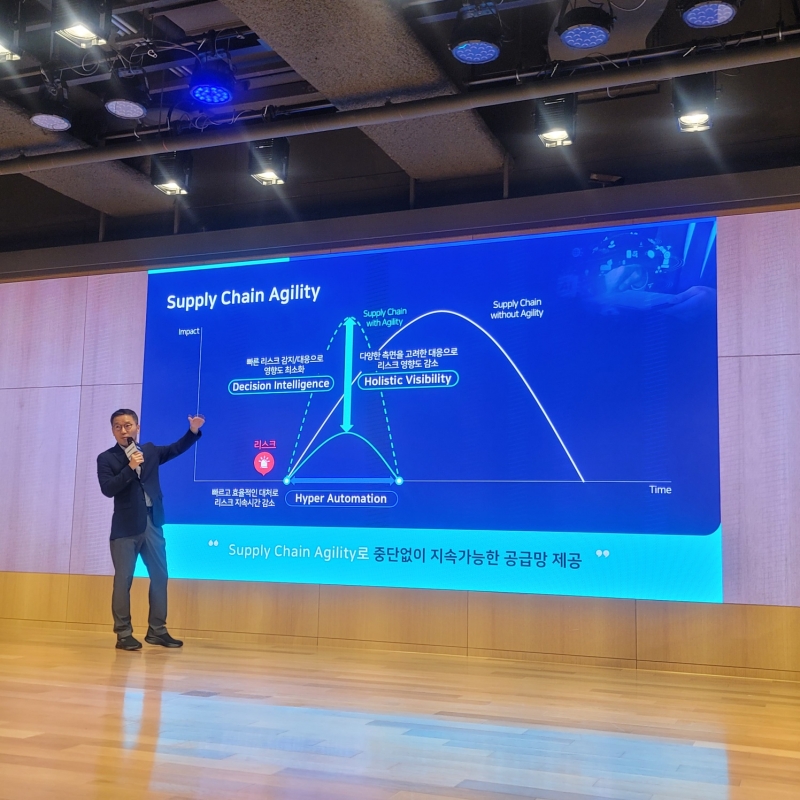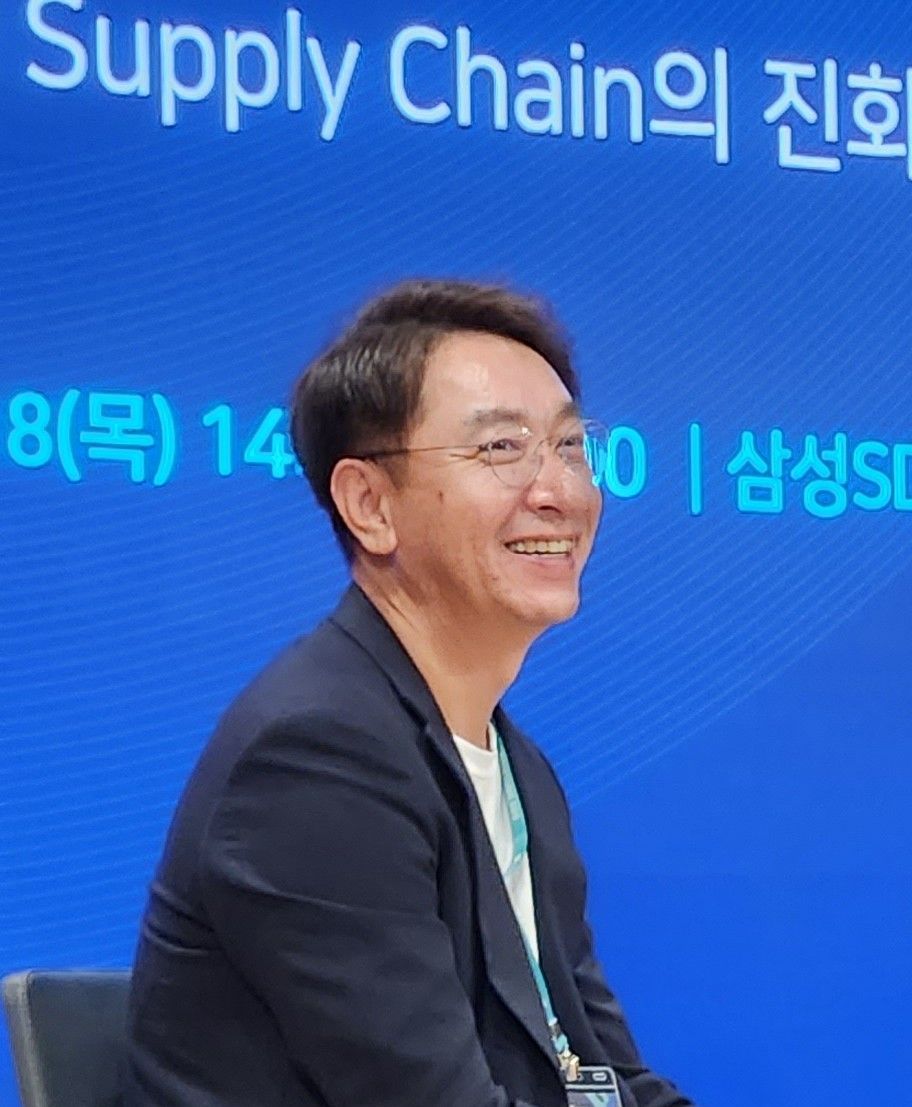Three Strategic Keywords for Creating 'Agility' in Samsung SDS Digital Logistics
🚢 Here's What You'll Learn from This Article!
- Samsung SDS has unveiled the next blueprint for its journey towards becoming a comprehensive digital forwarding service provider, leveraging the scalability of its logistics platform ‘Cello Square.’ However, there's an intriguing premise at the start: despite the advanced technologies applied to digital logistics, there is one fundamental issue that cannot be entirely overcome. The 'supply chain crisis' cannot be completely eliminated and must be accepted as an inevitable occurrence.
- Samsung SDS’s next logistics strategy blueprint is summarized by the keyword ‘Supply Chain Agility.’ Given that crises are bound to happen, the focus is on quickly recognizing and responding to them. To achieve this, three strategic approaches have been prepared: ‘Hyper automation,’ ‘Holistic Visibility,’ and ‘Decision Intelligence.’ You will learn the meaning of each keyword, related examples, and the future direction of Samsung SDS's logistics business.
- Hyper automation, Holistic Visibility, and Decision Intelligence. Just looking at these terms might not make their meanings clear. Breaking them down, hyper automation refers to 'automation using generative AI technology.' Holistic visibility means providing 'predictive visibility for future points in time,' going beyond past and present data. Lastly, decision intelligence refers to 'quick monitoring of crisis situations using AI technology.' You can learn about the latest trends in how Samsung SDS applies digital technology to logistics.
- In summary, Samsung SDS’s strategy is not significantly different from the core aspects of the business that have been emphasized repeatedly in the past. Agility in the supply chain, automation, and visibility have always been important. What has changed are the improved details compared to the past. You will understand why Samsung SDS believes that ‘digital logistics’ ultimately benefits not only customer shippers but also improves its own profitability.
CHAPTER 1
A Gap that Advanced Technology Couldn’t Overcome
We’ve already discussed how the core business of Samsung SDS's logistics division is shifting towards the logistics platform ‘Cello Square.’ This change is now reflected in the numbers. Last year, Cello Square's revenue was 560 billion KRW, more than doubling compared to 2022. In the first quarter of this year, Cello Square's revenue grew by 381% year-over-year to 255 billion KRW. This achievement stands out even more considering that the overall revenue of Samsung SDS's logistics division in the first quarter (1.6937 trillion KRW) saw a 12% decline compared to the same period last year.
According to Samsung SDS, Cello Square played a significant role in creating the ‘scalability’ of digital forwarding services. While the previous digital logistics business, Cello, which Samsung SDS had been operating since 2012, was limited to large enterprises with a certain level of digitalization represented by ERP (Enterprise Resource Planning) system expansion, Cello Square allowed anyone to sign up as a member, browse quotes for desired international logistics sections for free, and apply for related logistics services. This significantly increased the usage by medium and small business customers. As of the first quarter, the number of customer companies registered with Cello Square exceeded 12,200.
However, there is one challenge, or rather an inevitable premise, that Samsung SDS's digital logistics, which has achieved scalability, still hasn’t overcome. Advanced technology and digitalization cannot prevent the ‘supply chain crisis’ that comes to the logistics operating environment at any moment.
For example, right now, floods in southern Brazil have closed ports and airports, making it difficult to proceed with logistics services in those areas. The Houthi rebels in Yemen, who are blocking entry to the Suez Canal, continue to pose a threat. Although not confirmed yet, Samsung SDS anticipates a high possibility of a strike by the Canadian railway company crew union in the near future and is preparing to respond to this risk.
Various incidents arising from natural disasters and geopolitical relationships, whether small or large, will impact the supply chain. We remember the global supply chain congestion and freight rate surges triggered by COVID-19. We also recall the impacts on the supply chain from ongoing events such as the Ukraine-Russia war and the Israel-Hamas war. It is evident that no matter how advanced IT technology is, it is impossible for anyone to fundamentally prevent such issues.
Therefore, Samsung SDS assumed these supply chain crises as constants that inevitably occur rather than occasional variables. This is the background behind Samsung SDS emphasizing the core keyword of ‘Supply Chain Agility’ in its digital logistics business operations this year. While digital technology cannot fundamentally prevent crises approaching the supply chain, it can provide sufficient support for ‘agile response.’ Consequently, three major strategic keywords were established to create agility. The following is based on the account shared by Oh Goo-il, Executive Vice President of Samsung SDS's Logistics Business Division, at the Cello Square Media Day on the 20th.
CHAPTER 2
‘Hyper Automation’ Using Generative AI
The first strategic keyword highlighted by Samsung SDS is ‘Hyper Automation.’ While the term ‘hyper’ might seem a bit grandiose, according to Samsung SDS, it essentially represents the advancement of logistics automation through the use of ‘generative AI technology.’
In fact, Samsung SDS had already implemented a significant degree of ‘automation’ through the previous Cello Square. Currently, various company representatives can join the Cello Square platform, check the freight rates for their desired routes, and connect to request quotes and services. Since Samsung SDS reflects its profit in the freight rates provided to customers as a forwarding service provider, most features such as quote comparisons and market forecasts available on the platform are ‘free’ to use upon registration.
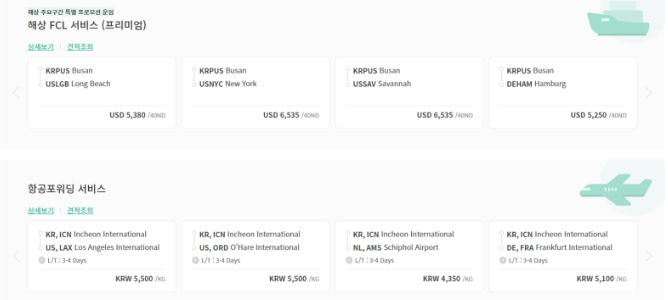
The benefits of automation created by applying generative AI can be found in the change in the ‘interface.’ Samsung SDS developed and updated a service that allows logistics service requests to be made conversationally through the ‘GPT Store,’ an application marketplace integrated with OpenAI’s ChatGPT. This service operates by learning from the diverse data and documents collected through the Cello Square platform, providing answers in natural language to user questions.
An example of Samsung SDS’s use of generative AI technology involves secondary batteries, which are classified as ‘hazardous materials’ due to the risk of fire and are subject to different handling regulations at various ports and airports worldwide. It’s not easy for logistics personnel to be aware of all these numerous regulations. If a logistics employee asks the chatbot, “What are the current hazardous material transport regulations at a specific port in China?” the AI can respond immediately based on the data it has learned, thereby improving work efficiency.
Another example is that while Samsung SDS already allows users to search for freight rate information for specific routes through Cello Square and compare this data, becoming proficient with all these platform functions can take some time. Instead, users can ask the chatbot questions like the freight rates for specific routes or the current location of their cargo, and the system is designed to provide related answers and link to downloads of volume and logistics cost data records, similar to asking a human logistics manager.
“These generative AI-based services are all services that Cello Square already possessed. What we have done is integrate these services with generative AI, enhancing accessibility and convenience for our customers. Instead of having to enter specific interfaces within the platform and input data values, customers can simply ask questions and receive answers.” - Oh Goo-il, Head of Logistics Business Division, Samsung SDS
CHAPTER 3
‘Holistic Visibility’ Opening the Future
The second strategic keyword highlighted by Samsung SDS is ‘Holistic Visibility.’ Similar to the automation with the hyper prefix, ‘visibility’ has long been a value that Samsung SDS has focused on. For instance, with the features implemented in Cello Square, you can check which route the ship carrying your cargo is taking and where it is currently located. This means that visibility information from the past to the present has been accessible for quite some time.
However, Samsung SDS has determined that the visibility customers want encompasses more than just that—it includes the ‘future.’ For example, more important than knowing that your cargo is currently near the Cape of Good Hope might be knowing when it will arrive at the destination port of Rotterdam, Netherlands, when the unloading process will begin, and when it can be connected to land transport.
Although existing carriers provide ETA (Estimated Time of Arrival), according to Samsung SDS, the accuracy of this ETA is particularly low in crisis situations, with recent figures falling below 50%. Even if the vessel arrives at the port, additional charges such as demurrage and detention fees can be incurred due to delays, making the management of punctuality even more critical.
Therefore, Samsung SDS is working through the platform to improve the predictability of future information compared to the past. Samsung SDS considers various past factors that affect ETA, such as whether there are stopover ports, the number of vessels waiting near a particular port, the number of berthing vessels, and the average waiting time. They then provide a separate ‘Predictive ETA’ to platform users. Although Predictive ETA cannot guarantee 100% visibility, it is designed to offer higher accuracy than the ETA provided by carriers, helping shippers prepare for potential crisis situations.
“From the shipper’s perspective, the impact of ETA is enormous. Depending on its accuracy, decisions about safety stock levels and production schedule adjustments are made, requiring various preparations. Therefore, providing more accurate predictive information is a very important point.” - Oh Goo-il, Head of Logistics Business Division, Samsung SDS
In addition, Samsung SDS provides another feature through the Cello Square platform to secure future visibility, called ‘market forecasts.’ Through market forecasts, users can receive predictive information not only on the historical and current trends of sea and air freight rates but also on ‘future segments.’
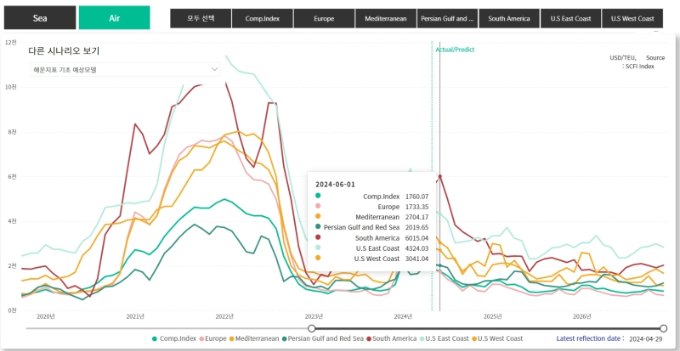
Of course, according to Samsung SDS, predictions about the future can never be entirely accurate. As mentioned earlier, unforeseen crises can always impact the supply chain and affect freight rates. Just as we couldn’t predict the Israel-Hamas war, this crisis could potentially spread to the entire Middle East, and its occurrence and timing are not easily predictable. In fact, Samsung SDS admits that these future predictions are often incorrect when the time comes.
However, according to Vice President Oh Goo-il, it is important that these market forecasts are based on ‘some grounds.’ Samsung SDS analyzes about 15 past factors, including demand and supply and capacity, using scientific methods to predict future freight rates. This data can be intuitively used by logistics managers at client companies of Samsung SDS when preparing annual reports. Every year, companies establish management plans to set logistics costs for the next year, and logistics managers also aim to estimate next year’s logistics costs based on past data. From this context, Samsung SDS believes there is a clear ‘need’ for this information among users.
CHAPTER 4
Creating Agility with ‘Decision Intelligence’
The third and final strategic keyword highlighted by Samsung SDS is ‘Decision Intelligence.’ This is a direct method to achieve the agile supply chain described earlier, enabling quick responses to inevitable supply chain crises.
According to Samsung SDS, effectively responding to supply chain crises requires first identifying what constitutes a ‘crisis’ among the countless events that occur daily worldwide. The challenge lies in the sheer volume of events, making it difficult to determine which ones are crises and which should be prioritized for response.
For example, Samsung SDS collects news data daily that could be potential crisis factors in the global market, amounting to about 60,000 pieces of information each day. Initially, Samsung SDS attempted to handle this information manually, but it quickly became apparent that this approach was highly inefficient.
To address this, Samsung SDS decided to utilize artificial intelligence technology. They used machine learning to study over 20,000 past incidents deemed to have had significant impacts on logistics. Leveraging generative AI technology, they can now filter the numerous daily events to identify those affecting logistics, reducing the number to approximately 750 significant events.
Once AI has completed this initial grading, human intervention follows. Logistics personnel at Samsung SDS focus on the 1st and 2nd grade risk factors to determine if they indeed represent potential crises. If an event is identified as a real crisis, they then verify which shipments from their customer shippers are exposed to this risk and collaborate with the customer's logistics managers to quickly find response strategies.
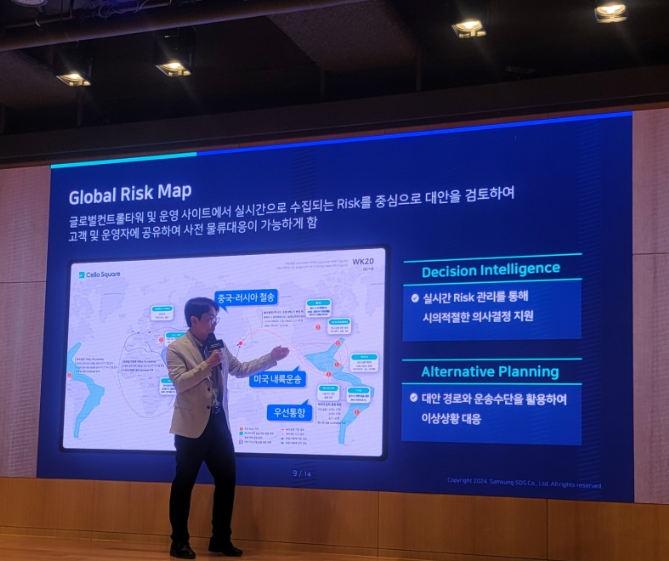
The dedicated center for identifying such crises is the ‘GCC (Global Control Center)’ located in the Pangyo office. Not only from Korea, but 56 hubs across 36 countries worldwide, established by Samsung SDS, participate together, creating a system that monitors logistics risks 24/7, 365 days a year. Customers using the Cello Square platform can also check the current crises and alternative route information through the visualized ‘Global Risk Map.’
"All global risks are marked on the map, allowing us to verify if these risks directly impact our logistics operations. This information is updated every two hours, and any identified risks are immediately checked through our logistics hubs. We then coordinate response strategies with our partners and inform our customer shippers accordingly. For example, earlier this year, a ship carrying our cargo was hit by a Houthi rebel missile, damaging the aft of the ship. Upon receiving this news, we immediately communicated with our nearby Dubai logistics office and the destination hub in Europe to assess the situation of the damaged ship. Using our system, we identified the ship’s location and the cargo it was carrying, and relayed this information to our customer shippers. We then contacted the shipping company to confirm if the ship could continue operating normally. Fortunately, although the ship was hit, its operation was not hindered. There was a slight delay, but the cargo was safely transported to its final destination." - Kim Sung-gon, Head of Cello Square Operations Team, Samsung SDS
CHAPTER 5
How Technology Contributes to an Agile Supply Chain
As mentioned at the outset, no matter how advanced the technology, it is impossible to completely eliminate risks in the supply chain. Therefore, Samsung SDS has determined that it is crucial to reduce the impact and duration of these inevitable risks. The three keywords discussed earlier all contribute to building an ‘agile supply chain,’ which can help mitigate the impact and duration of risks, as emphasized by Samsung SDS.
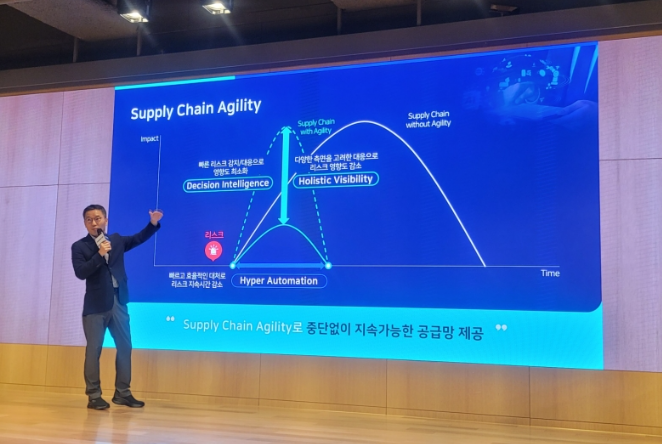
For example, ‘Holistic Visibility’ supports predicting the ‘future’ before a crisis occurs, allowing for the identification and preparation for potential signs of a crisis. Next, ‘Decision Intelligence’ aids in the rapid recognition of already occurring crises. Once a crisis is quickly recognized, an appropriate response system can also be rapidly established. According to Vice President Oh, these two keywords can significantly reduce the negative impacts of a crisis.
Typically, the response of logistics companies to supply chain risks involves using ‘alternative methods.’ If pirates appear in the Red Sea, which must be crossed to enter the Suez Canal, they might choose an alternative route via the Cape of Good Hope. Alternatively, they might arrange other transportation methods, such as air or rail transport, depending on the situation.
According to Samsung SDS, using alternative methods generally results in higher logistics costs than usual. However, it must be considered that simply facing the crisis without action could lead to cargo being stuck in certain sections, halting the entire business. The damage from such business standstills could be far greater than the increased logistics costs from choosing alternative routes, making swift responses crucial.
Next, ‘Hyper Automation’ supports rapid responses to detected risks. The core of hyper automation, as described by Samsung SDS, is to build an automated structure capable of responding to crisis situations even in the absence of human intervention. Consequently, quick responses can contribute to reducing the duration of risks, according to Samsung SDS.
Ultimately, Samsung SDS believes that ‘digitalization’ will benefit both customer shippers and their own profitability. Although they acknowledge that it is never easy to quantify the direct impact of digital technology on profitability, they believe that compared to doing nothing in response to supply chain crises, spending a bit more on logistics to quickly identify and respond to alternative networks results in significantly greater cost savings. They assert that digital technology plays a crucial role in this agile response.
“While it may vary by company and industry, logistics costs typically account for about 3-10% of a customer’s business expenses. If logistics costs increase, they might go up by 5% to as much as 50% within this range. However, if logistics are blocked and commercial invoices cannot be processed, it’s equivalent to the entire business of the shipper coming to a halt. I believe it is more rational and cost-effective to spend a bit more on logistics or find alternative solutions rather than facing risks that are 10 to 20 times greater than the logistics costs.” - Oh Goo-il, Head of Logistics Business Division, Samsung SDS
Furthermore, while the immediate factors directly affecting Samsung SDS's profitability are more related to changes in freight rates and cargo volumes due to market conditions rather than digital technology, digitalization can be used as a tool to enhance customer service, thereby attracting more customer shippers and increasing cargo volumes. They also believe it can help improve internal operational efficiency and reduce costs.
What are your thoughts after reading this far? Can digital technology truly emerge as a core competitive advantage in transforming logistics? We hope today’s content has been helpful to those preparing to launch or utilize digital logistics services.
Contact us and we'll help you learn more and connect your business. cs@beyondx.ai
